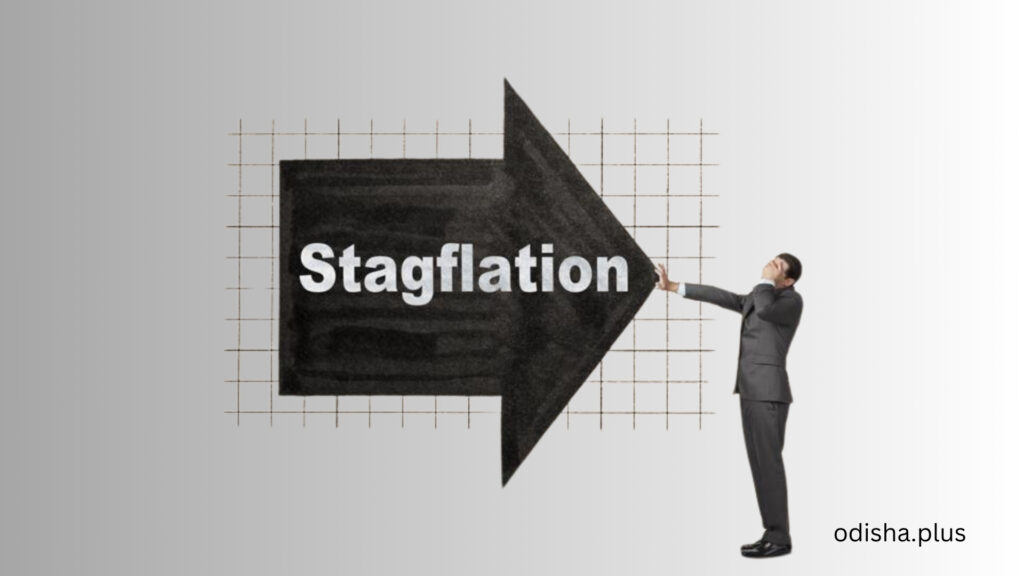Dr. Navya Gubbi Sateeshchandra

The global economy stands at a crossroads. The idyllic image of steady growth and stable prices, meticulously cultivated over decades, seems to be dissolving, replaced by the unsettling specter of stagflation. This pernicious economic phenomenon, a nightmarish confluence of stagnant economic growth and persistent inflation, casts an ominous shadow over the landscape. Memories of the 1970s, when a toxic brew of oil shocks, wage-price spirals, and policy missteps crippled economies worldwide, serve as a stark reminder of the devastation stagflation can wreak. Today, as we cross the treacherous economic terrain shaped by pandemic disruptions and geopolitical turmoil, the resilience of our institutions – central banks, international organizations, and national governments – will be the key to unlocking the labyrinth of stagflation and steering us towards a brighter economic future.
Stagflation is more than just a nasty combination of slow growth and high inflation. It represents a fundamental challenge to traditional economic tools and policies. In a healthy economy, central banks can typically combat inflation by raising interest rates, which discourages borrowing and investment, thereby dampening economic activity and ultimately slowing price increases. However, in a stagflation environment, raising interest rates risks further stifling an already sluggish economy, potentially leading to recession. Conversely, inaction on inflation can erode consumer confidence and fuel a dangerous cycle of wage-price spirals – where workers demand higher wages to keep pace with inflation, pushing businesses to raise prices further, creating a self-perpetuating loop that erodes purchasing power and stifles economic activity.
This complex scenario underscores the critical role of institutions in managing the perils of stagflation. The following sections will investigate deeper into the specific action central banks, international organizations, and national governments can take, but their success will ultimately hinge on their ability to act with foresight, resolve, and a commitment to long-term economic health. By harnessing the collective strength of these institutions, fostering global coordination, and prioritizing responsible economic conduct, we can chart a course towards a more resilient and stable economic future.
The specter of stagflation – a nightmarish fusion of stagnant economic growth and persistent inflation – looms large over the global landscape. The 1970s offer a haunting echo of this phenomenon’s destructive potential, a time when a toxic cocktail of oil shocks, spiraling wages and prices, and misguided policies crippled economies worldwide. As we confront this perilous path, one crucial factor stands out: the unwavering strength and effectiveness of our institutions will be the key to untangling this complex challenge and guiding us towards a more prosperous future.
The current economic climate presents a complex challenge. Disruptions wrought by the pandemic, exacerbated by the ongoing geopolitical crisis, have snarled supply chains, driven up energy prices, and choked off growth. Central banks, traditionally tasked with taming inflation, face a delicate tightrope walk. Raising interest rates to combat inflation could inadvertently suffocate a fragile economic recovery. Conversely, inaction on inflation risks eroding consumer confidence and fuelling a dangerous cycle of wage-price spirals.
In this critical juncture, the role of central banks like the Federal Reserve and the European Central Bank assumes paramount importance. Their monetary policy decisions will have a profound impact on global financial markets and economic activity. Striking a judicious balance between containing inflation and fostering growth necessitates not only a keen understanding of economic dynamics but also a steely resolve in the face of immense pressure.
Beyond central banks, international organizations like the International Monetary Fund (IMF) and the World Bank have a crucial role to play. They offer a platform for global economic coordination, fostering collaboration between nations in addressing shared challenges. By providing financial assistance to vulnerable countries and advocating for sound economic policies, these institutions can act as bulwarks against the destabilizing forces of stagflation.
National governments, too, have a critical stake in navigating this economic labyrinth. Implementing targeted fiscal policies that stimulate specific sectors of the economy while remaining mindful of long-term fiscal sustainability presents a delicate balancing act. Investments in infrastructure and green energy technologies, for instance, can foster long-term economic growth while mitigating inflationary pressures on energy prices. Additionally, targeted tax breaks and social safety nets can help cushion the blow for vulnerable populations disproportionately affected by inflation.
However, the efficacy of these strategies hinges on the resilience of national institutions. Robust regulatory frameworks that promote competition and prevent market distortions are essential in preventing inflationary pressures from taking root. Transparent and efficient bureaucracies facilitate the effective implementation of economic policies, ensuring that resources reach those who need them most. Moreover, a strong and independent judiciary fosters trust in the system and incentivizes responsible economic behaviour.
The threat of stagflation presents a formidable challenge, but it is not an insurmountable one. By harnessing the collective strength of our institutions – central banks, international organizations, and national governments – we can forge a path towards a more resilient and stable economic future. Central banks require the fortitude to chart a course that fosters price stability without stifling growth. International organizations must provide a platform for global economic coordination and offer critical support to vulnerable nations. National governments need to implement targeted fiscal policies that promote long-term economic health while alleviating the immediate burdens of inflation.
Yet, the success of these endeavours ultimately hinges on the strength of our institutions. Robust regulatory frameworks, efficient bureaucracies, and an independent judiciary serve as the cornerstones of a resilient economic system. By bolstering our institutions and fostering a culture of responsible economic conduct, we can navigate the perilous labyrinth of stagflation and emerge on the other side with a more robust and sustainable global economy. Overcoming the significant challenges posed by stagflation will pave the way for a more resilient and enduring global economic system.
Dr. Navya is a professor at berlin school of business & innovation, Berlin, Germany. Views expressed are personal






















